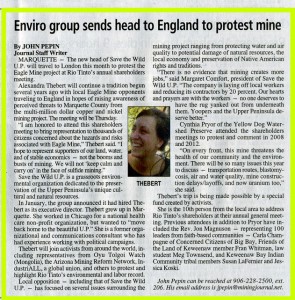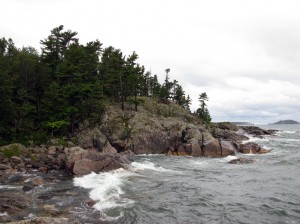April 5, 2013
MARQUETTE – Testing by Rio Tinto and the Superior Watershed Partnership has confirmed the presence of uranium in water samples from the bottom of a rock storage area at the Eagle Mine, which exceeds the federal maximum concentration level for safe drinking water.
The finding does not violate any state or federal regulatory permits at the mine, but technicians will continue monitoring and testing to learn more about the uranium.
“The significance largely is that it was unexpected and (yet) there it is, present; and trying to identify the source and is it being contained and removed,” said Jon Becker, a communications and development specialist with the Superior Watershed Partnership in Marquette. “We feel the public is going to be interested in that and we want to make sure that they know that we’re all looking at it and evaluating.”
Article Photos
Superior Watershed Partnership senior planner Geri Grant collects a water quality sample from the Temporary Development Rock Storage Area sumps at Rio Tinto’s Eagle Mine in Michigamme Township during the first quarter of 2013 verification monitoring.
The mine’s Temporary Development Rock Storage Area is designed to be an environmentally secure feature which holds waste rock from mining tunnel excavation until it is later put back underground to fill voids where ore was removed.
The bottom of the storage area has two multi-layered lining systems: a primary contact water sump and a lower secondary lining, called the leak detection sump.
Last month, a laboratory in Indiana determined a water sample taken from the leak sump in February by partnership staff – as part of its ongoing Community Environmental Monitoring of Rio Tinto’s mining activities – was found to contain 72.6 parts per billion of uranium.
Partnership staff was test sampling water quality in the leak sump to compare with previous test results produced by Rio Tinto.
Since December 1993, the U.S. Environmental Protection Agency has been regulating uranium in community drinking water supplies to reduce the risk of kidney disease and cancer.
A Western Upper Peninsula Health Department advisory on uranium said the EPA standards for safe drinking water are based on assuming a person drinks two liters of water each day for 70 years.
The EPA maximum concentration level for uranium under the Safe Drinking Water Act is 30 parts per billion, with concentrations exceeding that level considered unsafe. Consequently, the laboratory was required by law to report the uranium level from the leak sump water sample.
“It’s a reporting requirement of the act because they don’t necessarily know what the source of that water is,” Becker said. “If it was a drinking well, it’d be an issue of concern. This is not drinking water.”
Rio Tinto’s rock storage area and water treatment plant are not governed by the Safe Drinking Water Act, but by the company’s mining and groundwater discharge permits.
Dan Blondeau, a Rio Tinto spokesman in Humboldt, said the estimated 26,000 gallons of water in the leak sump came primarily from rain that fell when the rock storage area was being built three years ago.
Since September 2011, Rio Tinto has removed 2,864 gallons of that water to contact water basins and then to the mine’s water treatment plant for processing.
Blondeau said that process includes ion exchange and reverse osmosis filtration, which are two methods federal regulators recommend for removing uranium from drinking water.
After being treated, water is either recycled back into the mining process or discharged into the ground through the mine’s treated water infiltration system.
“The mine site is designed to collect and treat water that comes into contact with mining activities,” said Eagle Mine environmental and permitting manager Kristen Mariuzza. “We are confident in the system and the methods being used to ensure that only clean water is released back into the environment.”
Becker said the partnership has tested water going into the treatment plant and coming out of it to see if the uranium is being removed. Results are due back from the lab next week.
Until then, Becker declined to speculate on the possible impact.
“Just the word (uranium) is going to be alarming to some people,” Becker said. “It’s helpful to know that the processes that are in place at the water treatment plant are the processes that EPA recommends as the best treatment. But until we have monitoring results that demonstrate the efficiency of that, we don’t want to speculate.”
Meanwhile, Blondeau said tests on solid wastes from the water treatment plant showed uranium levels consistent with Upper Peninsula geology in one waste test and none in another, indicating the treatment plant is successfully removing the uranium.
However, those results have not been substantiated independently by the partnership, which will make new similar tests next week. The solids removed by the process are disposed of at a municipal landfill.
When the initial leak sump water sample results were received from the lab in mid-March, partnership staff quickly returned to the mine to retest the water.
Expedited results from the partnership’s lab showed uranium levels of 61 and 58 parts per billion and no uranium in the contact water sump.
Rio Tinto’s test results from its samples and lab showed 56 parts per billion of uranium in the leak sump and a low concentration of 0.13 parts per billion in the contact water sump.
To help identify the source of the uranium, the partnership requested core samples from Rio Tinto in addition to samples of the waste rock and the aggregate used in the storage area leak detection liner.
Steve Casey, district supervisor for the Michigan Department of Environmental Quality’s water resources division at K.I. Sawyer, said he thinks the uranium source may be the aggregate. If obtained from a Big Bay area quarry nearby, the material may contain Jacobsville sandstone.
The sandstone is known from several counties in the U.P. and its formation extends along the Lake Superior shoreline, east toward Big Bay.
Casey said the sandstone’s composition is known to include uranium, while the waste rock from the mine portal is not.
One Michigan Technological University study focused on testing bedrock wells in Jacobsville sandstone found 25 percent of 270 wells tested with uranium exceeding the EPA maximum concentration limits.
Casey characterized the uranium detection at the Eagle Mine as “not terribly surprising or uncommon.”
“We’ve seen numbers about three times that high in wells,” Casey said.
Casey said the DEQ tested 419 private wells and 20 percent exceeded the safe drinking water standard for uranium, including one well registering 202 parts per billion.
Western U.P. Health Department materials said uranium occurs naturally in some area bedrock and groundwater, making wells susceptible to contamination. High levels of uranium have been found in Baraga, Houghton, Keweenaw, Gogebic and Ontonagon counties.
The department said “the amount of uranium in bedrock and well water will vary greatly from place to place and without testing, it is not possible to determine if the water is safe for drinking.”
Health department officials said bathing and showering with water containing uranium is not a health concern.
Construction of the Eagle Mine’s rock storage area began in September 2010. By October, the secondary liner was installed and a leak survey performed. The primary liner, risers and the pumping system was completed by November.
In September 2011, the DEQ approved a certificate of quality assurance for construction of the liner systems. That same autumn, Rio Tinto began monitoring the rock storage area as it began digging the mine portal and storing waste rock.
Becker said early last year, Rio Tinto also discovered elevated sulfate levels, which periodically were above the reporting level and have been trending downward since August 2012.
A mining company investigation did not identify a source, but similar to Casey’s uranium source theory, Rio Tinto speculated a small amount of sulfate material was contained in the aggregate used to build the liner.
Monitoring of sulfates and uranium will continue regularly by Rio Tinto and the partnership, with results reported to the public at:www.cempmonitoring.org.
John Pepin can be reached at 906-228-2500, ext. 206.
http://www.miningjournal.net/page/content.detail/id/585930/Uranium-found-at-mine-location.html



